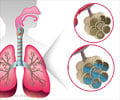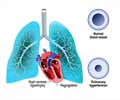
‘This study claims that the protein NT-proBNP may be used as a biomarker to accurately diagnose or rule out acute heart failure in patients seen for shortness of breath at hospital emergency departments.’
Tweet it Now
NT-proBNP (N-terminal pro-brain natriuretic peptide) and a related protein called BNP (B-type natriuretic peptide) are both produced when the cardiac muscle is under stress. One of the earliest studies of the value of NT-proBNP testing, conducted in the MGH Emergency Department, suggested age-based diagnostic cutoffs for diagnosis of heart failure- 450 pg/ml for patients under 50, 900 pg/ml for those 50 to 75, and 1,800 pg/ml for those over 75. An NT-proBNP level of 300 or below appeared to rule out acute heart failure no matter the patient's age. Use of those cutoffs was supported by a larger, multi-institutional trial, but while they have been largely adopted at hospitals worldwide, the only NT-proBNP diagnostic cutoffs approved by the U.S. Food and Drug Administration (FDA) are 125 pg/ml for patients under 75 and 450 pg/ml for those 75 and older - levels designed for use in conjunction with outpatient treatment. The current study, conducted by the Baim Institute for Clinical Research, and led by Januzzi, was designed both to validate the emergency-care-based cutoffs and to determine whether they remain useful for assessment of the current population of patients with heart failure.
Conducted in 2015 and 2016 at 19 sites in the U.S. and Canada, the study enrolled 1,461 adult patients who had come to hospital emergency departments with shortness of breath or other breathing difficulties. Blood samples to be measured for NT-proBNP levels were taken upon study enrollment, and determination of the presence of acute heart failure - separate from the clinical diagnosis that guided participants' care - was made by clinicians blinded to individual participants' NT-proBNP levels. Overall, 277 patients - 19 percent of total study enrollment - were determined to have acute heart failure.
Comparison of participants' NT-proBNP levels with their eventual diagnoses supported the usefulness of the age-based cutoff levels and that a level below 300 strongly excluded a heart failure diagnosis. These results were consistent across all groups of participants, no matter their age, gender, racial or ethnic background or the presence of conditions like obesity or kidney disease.
"We found no specific population in which the test did not perform well, and what was most striking to me - as someone who has been working with NT-proBNP since the early 2000s - was how consistent these results were with those of prior studies," says Januzzi, who is the Hutter Family Professor of Medicine in the Field of Cardiology at Harvard Medical School. "Given the changes in the types of patients with heart failure we see today, it's quite remarkable how reliable this test is."
Advertisement
Source-Eurekalert















